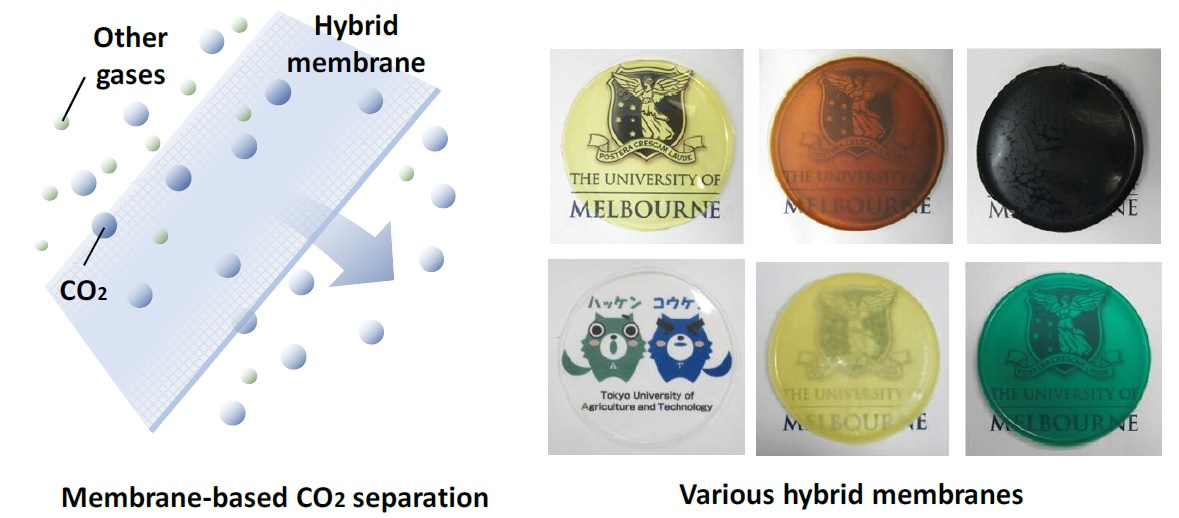Evaluation of novel hybrid membranes
November 2, 2017
Academics from Japan and Australia have assessed the effectiveness of novel hybrid materials known as mixed matrix membranes, to capture carbon dioxide and mitigate against global warming.
Led by Assistant Professor Shinji Kanehashi from the Division of Applied Chemistry at Tokyo University of Agriculture and Technology and Honorary Fellow at the University of Melbourne, together with Professor Sandra Kentish from the University of Melbourne’s Peter Cook Centre for Carbon Capture and Storage Research, these novel materials are derived from a polymer combined with porous nanoparticles formed from metal organic frameworks, porous organic polymers, or activated carbon.
Assistant Professor Kanehashi said “Although a large number of gas separation membrane materials have been reported for CO2 capture in the last few decades, most have been tested under ideal conditions. However, real industrial gas streams contain impurities such as water vapor, hydrogen sulfide, sulfur dioxide and nitrogen oxide. ”
“We have investigated the resilience of the hybrid membranes in the presence of these impurities. We found that the hybrid membranes prepared using porous organic polymer nanoparticles were resilient to these impurities. This means that they can be effective in gas separation applications such as natural gas sweetening, biogas purification and post-combustion carbon capture, when these acidic gases are present.”
Professor Kentish said “Membrane technology is one approach being investigated globally for the cost-effective capture of the carbon dioxide. However, to be successful, the membrane materials require high gas permeability and selectivity as well as long-term performance stability. These results will allow scientists and engineers to select the right materials for these applications.”
Carbon dioxide (CO2) capture remains a priority in many countries as the world seeks to address climate change. In particular, the most recent report from the Intergovernmental Panel on Climate Change shows that geological storage of carbon dioxide is required for all scenarios that can meet 430‐550 ppm CO2 atmospheric concentrations (Working Group III, IPCC 5th Assessment Report, 2014).
This research was partially supported by the Science and Industry Endowment Fund (SIEF), Australia and Grant-in-Aid for Young Scientists (B) (Grant No. 17K14850) from the Ministry of Education, Culture, Sports, Science and Technology of Japan.
This research achievement is published online in Journal of Membrane Science (Impact Factor: 6.035, 2016), Elsevier on October 31, 2017.
Title: Effects of industrial gas impurities on the performance of mixed matrix membranes (DOI: 10.1016/j.memsci.2017.10.056), Author: Shinji Kanehashi, A. Aguiar, H. Lu, G. Chen, S. Kentish
Dr. Kanehashi also received Award for Encouragement of Research in Polymer Science, the Society of Polymer Science, Japan (May 2017) as a part of this research achievement.

Related Information
Research factors:http://www.rd.tuat.ac.jp/en/activities/factors/index.html
UOM: http://petercook.unimelb.edu.au
Journal of Membrane Science: http://www.sciencedirect.com/science/article/pii/S0376738817321907
Contact
Shinji Kanehashi
Assistant Professor, Division of Applied Chemistry, Institute of Engineering,
Tokyo University of Agriculture and Technology, Japan
Tel +81-42-388-7212
Email kanehasi(insert @ symbol here)cc.tuat.ac.jp
Sandra Kentish
Head of the School of Chemical and Biomedical Engineering, Professor,
University of Melbourne, Australia
Tel +61-8344-6682
Email sandraek(insert @ symbol here)unimelb.edu.au
